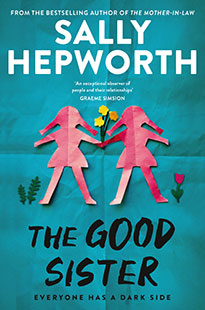 An easy, one-evening read, The Good Sister is an engaging twist on sisterly dynamics. And I use the word ‘twist’ intentionally.
An easy, one-evening read, The Good Sister is an engaging twist on sisterly dynamics. And I use the word ‘twist’ intentionally.
When I sat down to read The Good Sister, I was a little anxious that the book may have been the next in a meaningful sequence. A sequence, I might add, of which I was unfamiliar. Sally Hepworth’s previous works are apt to give one this impression: Each title references something about family.
When first into this book, I decided I was thoroughly confused. I didn’t much like one of the characters. And I started getting annoyed… until, that is, I realised that I had missed the sequencing, which blazes out from the page in each heading. Thus, I went back to the beginning and started again.
You’ll be happy to note that my lackadaisical reading style is my problem, not the author’s.
The Good Sister is about two women: Twins. One, Fern, is autistic. Her narrative provides startling insight into sensory overload, failures of ‘regular’ communication, and the mysteries of human connection. Fern’s twin, Rose, is kind and helpful, seeking only to help her ‘disabled’ sister to succeed, despite her own world falling to pieces.
The author alternates between Fern’s experiences and Rose’s journal entries. Rose is apparently in therapy because her marriage is on the rocks. She is so desperate to have kids that her husband scarpered. When Fern is made aware of Rose’s apparent inability to conceive, she decides to have a baby for her sister.
She believes that she is not a suitable mother, and that this is the least she could do for her twin. Along the way, she falls in love with ‘Wally’: A wealthy minimalist who looks like the famous character in Where’s Wally? books.
The ladies’ mother is in a nursing home, unable to speak. She is apparently brain damaged due to an overdose.
Early on, we understand that Rose’s and Fern’s upbringing was unsavoury: An unstable, addict mother who treated the girls abusively; a murder apparently perpetrated by Fern and hidden by Rose. And a lifetime of guilt and avoidance.
Yet Rose isn’t the woman she appears to be.
Nor is her story.
Hepworth spins this tale with an adept hand. Rose is a difficult character to like, right off the bat. If you’d been sitting next to me as I read, you’d have copped more than one exclamation about how much I disliked her. Fern, in contrast, is endearing and intriguing.
By the time I got to the plot twist, I already had it sussed – but the point of this book isn’t to be surprised or shocked by the twist itself. It’s the impact of the twist on Hepworth’s characters that is of far greater import.
Uncommon as it is to encounter a character with Fern’s attributes, many of us know someone like her. Standing on the outside as we often are, it can be difficult to understand such people and their reticence to participate in social, fun events.
Why can they be strange conversationalists? And how do they navigate the world? You get an insight into all of this from The Good Sister. I admit to reflecting on my own patterns of speech, for example, realising that easy banter is so terribly prone to misunderstanding.
In the acknowledgements, Hepworth hints in at the grey line of appropriateness that exists between sisters. Though if one was to ascribe a social commentary to this story, it’s that you can never know the motivations and perspectives of anyone else. Not your spouse. Not your friends. Not even those with whom you’ve grown up and shared a life.
This book is enough of a page-turner that you can easily enjoy it in one evening. Perhaps, like me, you’ll get to the end and be surprised that your night just disappeared.
The Good Sister is published by Pan Macmillan Australia and available at all leading book sellers including Booktopia.
Image: The Good Sister – courtesy of Pan Macmillan Australia
Review: Leticia Mooney
